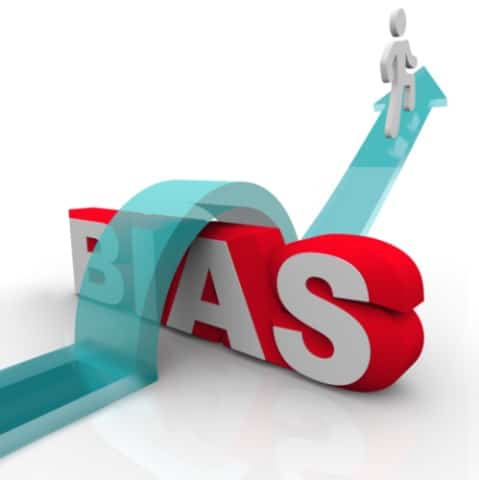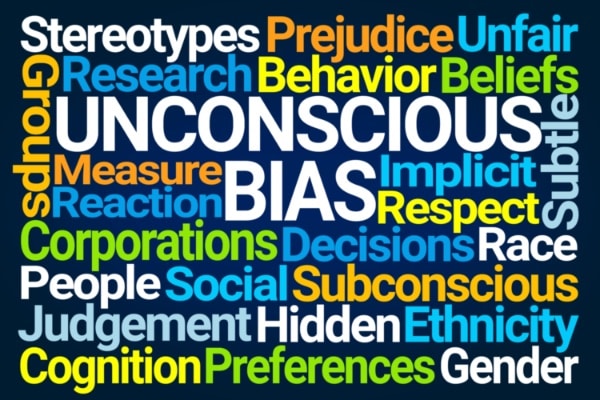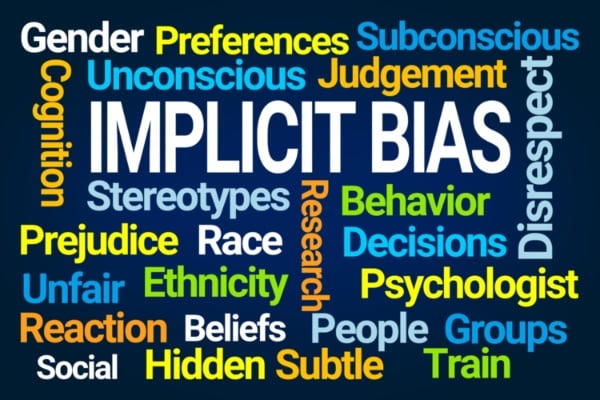How Does Unconscious Bias Affect The Workplace?

Unconscious biases are embedded in every human being around the world. In the workplace, prejudices influence important hiring decisions, employee pay, promotions, socializing, cultural context, and more. Unconscious bias is rooted in prejudice and can drastically impact a person and a company.
Companies must be aware of and address unconscious bias to help prevent its implications. Companies can improve awareness and work toward inclusion and workplace diversity through unconscious bias training.
Reducing discriminatory practices associated with workplace bias can contribute to a positive work environment, increase diversity, improve the hiring process, reduce turnover, and increase workplace productivity. We also have an unconscious bias training video for employees that you should check out.
What is Unconscious Bias?
Implicit bias is the phenomenon of unintentionally favoring or disfavoring someone based on societal stereotypes and learned assumptions. Everyone develops biases, some of which people are unaware they have. Confirmation bias can further this, as people look for information and examples that merely confirm their beliefs.
How does unconscious bias affect people? People’s decision-making process includes how they treat others, who they befriend and dislike, where they live, and where they work. Biases cause people to discriminate and treat people who are different from them unfairly.
Different cultures, certain groups, or societies can share an unconscious bias. These biases stem from various places and are typically passed down from generation to generation. While some have been prominent throughout human history, such as gender biases and racism, other biases change with the times, like beauty prejudices and ageism.
Experiencing discrimination can affect a person’s entire well-being and sense of self and influence their life significantly. A perpetrator of unconscious bias is doing themselves a disservice by making decisions based on assumption rather than reality.
There are real-world consequences to implicit bias, especially in a work environment. But what is the impact of unconscious bias in the workplace?

What Impact Does Bias Have on Work and Personal Life?
Experiencing discrimination at work can affect someone in all aspects of their life. Regardless of the severity or the workplace implications, the person will typically feel their value diminished.
Many aspects of their work life and personal life may feel more difficult and more time-consuming, perhaps without them realizing why. Whether they know they have experienced bias or not, they are running a race with hurdles others don’t need to overcome. This leads to increased stress and feelings of alienation and rejection.
Of course, the tangible implications of biases in the workplace can significantly influence pay and, therefore, quality of life. Being passed over for jobs or promotions can decrease self-esteem and motivation.
Real consequences can affect a person’s ability to do their job or confidently feel comfortable around their coworkers. The emotional toll discrimination can take in and out of work can shape a person’s entire life.
What Is Bias and How Does It Affect the Workplace?
Different types of unconscious bias affect people and the working environment differently. Many prejudices are based on a person’s appearance, but others form stereotypes around a person’s background, financial means, personal beliefs, or behaviors.
The bottom line is that unconscious bias is inside every human brain. However, it affects everyone differently, some positively and some negatively. All people let their own biases influence their decisions to different degrees or not at all. Look at the following workplace examples to increase awareness of how workplace unconscious bias shapes a company.
Racial Bias
Racial bias is the preferential treatment of a certain race over others. Typically, people favor their own race versus someone of a different race. White individuals are more likely to receive interviews and callbacks for jobs in a work setting than non-white individuals.
Gender Bias
Gender bias is favoring one gender over another. In the workplace, this traditionally refers to the preferential treatment of men over women. Many industries have the ideology of gender roles that place women in different positions than men.
Age Bias
This refers to the assumption of someone’s age and the negative treatment of them based on that. Older employees typically experience this negative bias more than young employees. For example, it may be assumed that the older someone is, the less they understand how to use a computer. The EEOC recognizes age bias as a big problem, and they have laws on the books to limit its spread.

Affinity Bias
Affinity bias refers to the theory that people choose to be around people who are similar to themselves. From a business perspective, this means hiring people of the same race or gender, from the same city, or who have similar hobbies.
Conformity Bias
Conformity occurs when someone is peer pressured and defers from their true options to fit in with a group. This can negatively influence their work; for example, a hiring team member could choose a candidate simply because others on the team did so.
Appearance Bias
Also known as beauty bias, this refers to people making assumptions about someone based on their physical appearance. People who are taller and of average weight are often more likely to be promoted.
Prejudices against appearances vary greatly across industries, cultures, and individuals. The main takeaway is that a person is judged based on appearance rather than job performance, intelligence, personality, or anything else.
Microaggression Bias
These biases take the form of subtle insults, negative attitudes, or negative communication to or about someone in a marginalized group. This is considered an unconscious bias when the perpetrator is unaware they are doing this. This behavior can negatively affect a work environment and take a toll on the victim of this bias.

The Halo Effect
This describes the theory that someone can judge an individual solely based on their brief first impression of them or a single characteristic they have. From this single impression, they form an entire view of them. In the halo effect, a person puts a “halo” around the other person because of a characteristic that they deem impressive or good and therefore thinks of the person as impressive or good.
For example, a hiring manager could “put a halo” on a candidate from a prestigious university and choose them for the job regardless of if they were the most qualified candidate.
The Horns Effect
This theory is the opposite of the halo effect. A person takes one specific trait or a brief impression of a person and uses that to form their opinion of the person. Contrary to the halo theory, the horns effect describes negative assumptions.
For example, the hiring manager thinks candidates who went to a community college are less intelligent than candidates who went to a state college. Therefore, they do not read the resumes of candidates with a community college degree. This hiring manager formed their opinion of the candidates based on one characteristic.
What Are Some Unconscious Bias in the Workplace Examples?
Whether companies are aware of it or not, unconscious bias seeps into all the decisions people make. A company’s bias affects all employees, some positively and others negatively. In all cases, bias is an unethical and unfair way to conduct business. The below examples illustrate unconscious bias in action and how it can shape a person and a company.
Hiring Process
Entering the workforce and finding a job they are happy with is an uphill battle for many people. The recruitment process can be daunting and time-consuming. Especially considering that traditional hiring practices accommodate biases and unintentional prejudice thrives.
Name bias is prevalent in the hiring process and refers to the idea that a person’s name is associated with social stereotypes. A person’s name could lead to racial or ethnic discrimination as well as gender assumption and more. A hiring manager may not realize they are doing so but may favor candidates with names they believe belong to someone with the personality traits they are looking for.
Many companies are electing to screen resumes without names or elect gender-neutral language. While this avoids the issue initially, the candidate’s name or the candidate will eventually need to be seen by the hiring manager.
Promotion Opportunities
Despite the employee’s experience and job performance, many managers select promotions based on personal preferences and social connections with people. Also, studies have shown that women and minorities are less likely to be hired for or promoted to leadership roles versus white male counterparts with identical resumes. This can be blatant to employees who are up for promotion, but the manager may not realize or understand their biases.
For instance, the manager may be experiencing an unconscious appearance preference against two employees up for a promotion. The first employee is fit, and the second is not in shape. The manager may unknowingly think that the first employee appears more professional than the second and promote them regardless of qualifications and experience.
Pay Discrepancy
Pay discrepancies among people who do the same job but are of different backgrounds are a clear, quantifiable way to evaluate bias in the workplace. The infamous gender pay gap, while caused by a long world history of sexism, is still a prevalent issue in modern companies worldwide. Gender bias occurs when men and women do the same job for the same number of years and perform similarly, but the man is paid more. This issue is also prominent for minorities and LGBTQ plus associated persons.
The gender pay gap is relevant across all industries, from entry-level to chief-level executives. The median earnings for women are significantly lower, even in historically female positions or have a majority female workforce, such as school teachers and nurses.
Socializing
When it comes to socializing with co-workers in and outside of work, unconscious bias fuels an unhealthy, negative work environment for all. People’s preconceived notions of one another are what form cliques and breed favoritism in the workplace.
For example, a group of coworkers goes out to a nice happy hour every Friday. They exclude the young intern because they assume he is immature and can’t afford to attend. Due to their assumptions, the group makes no effort to get to know the intern and learn how he behaves or can spend money. A person’s socioeconomic class can significantly shape their opportunities to network and open them up to judgment.

Workplace Unconscious Bias Affects The Success of a Business
Although many modern companies are working to improve diversity and combat the effects of unconscious bias to drive value, it is still a prominent issue that hinders a company’s true potential.
Companies need to anticipate and mitigate unconscious bias for several reasons. The discriminatory practices bred by unconscious bias cause tangible problems for companies, such as lawsuits and emotional and psychological factors for employees.
Overall, a work atmosphere with rampant bias hinders the success of the company in many areas:
- Choosing the wrong candidate for a job. Without an open mind, the talent pool for a position is smaller.
- Not getting the most out of employees. It is a poor business strategy to assign roles and tasks based on bias rather than on who is best suited for it.
- It affirms a negative work environment that damages the employee experience and reduces employee performance.
- Employees leave due to frustration. A high employee turnover rate. High turnover costs time, money, and loss of productivity.
- Promoting the wrong employees that are not suited for the job is counterproductive.
- Damaging your brand. This is an extremely important issue for companies to maintain or achieve success.
- Creating cause for discriminatory legal action. This consequence brings legal costs, bad press, increased accidents, and unhappy employees.
Moving Forward
There are tools that companies can use to tackle unconscious bias and increase inclusivity and diversity. Awareness is the foundation for modifying mindsets and behaviors that reduce unconscious bias. Business leaders can prioritize tackling unconscious bias through company-wide training and anti-discrimination policies. If people have a willingness to learn and a concern for unconscious bias at work, training can be highly successful.
Training typically consists of group discussions and self-reflection to understand different perspectives and be aware of personal biases. These discussions affect people differently; some employees may be more eager to unlearn stereotypes than others. A good starting point for these discussions is a list of unconscious bias discussion questions your team can discuss, work through, and chew on. The ultimate goal is understanding and learning to make decisions with your conscious mind rather than unconscious biases.
Conclusion
As companies begin to implement training and encourage all employees to be aware of unconscious biases, the unfortunate consequences of prejudices can improve naturally and build a positive environment for inclusion, diversity, and productivity. Overall, we do know that biases can affect the workplace, and our goal should be to stop this behavior in its tracks.